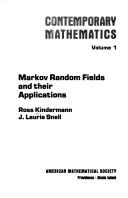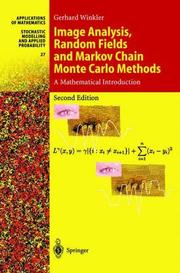| Listing 1 - 5 of 5 |
Sort by
|

ISBN: 0821850016 0821833812 9780821850015 Year: 1980 Volume: 1 Publisher: Providence (R.I.): American mathematical society,
Abstract | Keywords | Export | Availability | Bookmark
 Loading...
Loading...Choose an application
- Reference Manager
- EndNote
- RefWorks (Direct export to RefWorks)
Markov random fields --- Markov random fields. --- Mathematics --- Physical Sciences & Mathematics --- Mathematical Statistics --- 519.217 --- Markov processes --- 519.217 Markov processes --- Fields, Markov random --- Random fields
Book
ISBN: 0387907084 3540907084 1461381924 1461381908 9780387907086 9783540907084 Year: 1982 Publisher: New York: Springer,
Abstract | Keywords | Export | Availability | Bookmark
 Loading...
Loading...Choose an application
- Reference Manager
- EndNote
- RefWorks (Direct export to RefWorks)
Stochastic processes --- Random fields --- Vector fields --- 519.217 --- Markov random fields --- Direction fields (Mathematics) --- Fields, Direction (Mathematics) --- Fields, Slope (Mathematics) --- Fields, Vector --- Slope fields (Mathematics) --- Vector analysis --- Fields, Markov random --- Markov processes --- 519.217 Markov processes
Book
ISBN: 9783319149141 331914913X 9783319149134 3319149148 Year: 2015 Publisher: Cham : Springer International Publishing : Imprint: Springer,
Abstract | Keywords | Export | Availability | Bookmark
 Loading...
Loading...Choose an application
- Reference Manager
- EndNote
- RefWorks (Direct export to RefWorks)
This work covers sequence-based protein homology detection, a fundamental and challenging bioinformatics problem with a variety of real-world applications. The text first surveys a few popular homology detection methods, such as Position-Specific Scoring Matrix (PSSM) and Hidden Markov Model (HMM) based methods, and then describes a novel Markov Random Fields (MRF) based method developed by the authors. MRF-based methods are much more sensitive than HMM- and PSSM-based methods for remote homolog detection and fold recognition, as MRFs can model long-range residue-residue interaction. The text also describes the installation, usage and result interpretation of programs implementing the MRF-based method.
Computer Science. --- Computational Biology/Bioinformatics. --- Probability and Statistics in Computer Science. --- Bioinformatics. --- Statistics for Life Sciences, Medicine, Health Sciences. --- Computer science. --- Statistics. --- Informatique --- Bio-informatique --- Statistique --- Biology --- Health & Biological Sciences --- Biology - General --- Proteins --- Homology theory. --- Markov random fields. --- Mathematical models. --- Structure --- Fields, Markov random --- Cohomology theory --- Contrahomology theory --- Proteids --- Mathematical statistics. --- Algebraic topology --- Random fields --- Biomolecules --- Polypeptides --- Proteomics --- Informatics --- Science --- Bio-informatics --- Biological informatics --- Information science --- Computational biology --- Systems biology --- Statistical analysis --- Statistical data --- Statistical methods --- Statistical science --- Mathematics --- Econometrics --- Data processing --- Statistics . --- Statistical inference --- Statistics, Mathematical --- Statistics --- Probabilities --- Sampling (Statistics)
Book
ISBN: 1849967679 1848002785 9786612068867 1282068865 1848002793 Year: 2009 Publisher: London : Springer,
Abstract | Keywords | Export | Availability | Bookmark
 Loading...
Loading...Choose an application
- Reference Manager
- EndNote
- RefWorks (Direct export to RefWorks)
Markov random field (MRF) theory provides a basis for modeling contextual constraints in visual processing and interpretation. It enables systematic development of optimal vision algorithms when used with optimization principles. This detailed and thoroughly enhanced third edition presents a comprehensive study / reference to theories, methodologies and recent developments in solving computer vision problems based on MRFs, statistics and optimization. It treats various problems in low- and high-level computational vision in a systematic and unified way within the MAP-MRF framework. Among the main issues covered are: how to use MRFs to encode contextual constraints that are indispensable to image understanding; how to derive the objective function for the optimal solution to a problem; and how to design computational algorithms for finding an optimal solution. Easy-to-follow and coherent, the revised edition is accessible, includes the most recent advances, and has new and expanded sections on such topics as: Conditional Random Fields; Discriminative Random Fields; Total Variation (TV) Models; Spatio-temporal Models; MRF and Bayesian Network (Graphical Models); Belief Propagation; Graph Cuts; and Face Detection and Recognition. Features: • Focuses on applying Markov random fields to computer vision problems, such as image restoration and edge detection in the low-level domain, and object matching and recognition in the high-level domain • Introduces readers to the basic concepts, important models and various special classes of MRFs on the regular image lattice, and MRFs on relational graphs derived from images • Presents various vision models in a unified framework, including image restoration and reconstruction, edge and region segmentation, texture, stereo and motion, object matching and recognition, and pose estimation • Uses a variety of examples to illustrate how to convert a specific vision problem involving uncertainties and constraints into essentially an optimization problem under the MRF setting • Studies discontinuities, an important issue in the application of MRFs to image analysis • Examines the problems of model parameter estimation and function optimization in the context of texture analysis and object recognition • Includes an extensive list of references This broad-ranging and comprehensive volume is an excellent reference for researchers working in computer vision, image processing, statistical pattern recognition and applications of MRFs. It is also suitable as a text for advanced courses relating to these areas.
Image processing --Digital techniques --Mathematical models. --- Markov random fields. --- Image processing --- Markov random fields --- Engineering & Applied Sciences --- Applied Physics --- Digital techniques --- Mathematical models --- Mathematical models. --- Fields, Markov random --- Pictorial data processing --- Picture processing --- Processing, Image --- Computer science. --- Computer science --- Image processing. --- Pattern recognition. --- Probabilities. --- Computer Science. --- Image Processing and Computer Vision. --- Pattern Recognition. --- Probability Theory and Stochastic Processes. --- Mathematics of Computing. --- Mathematics. --- Probability --- Statistical inference --- Combinations --- Mathematics --- Chance --- Least squares --- Mathematical statistics --- Risk --- Design perception --- Pattern recognition --- Form perception --- Perception --- Figure-ground perception --- Imaging systems --- Optical data processing --- Computer mathematics --- Discrete mathematics --- Electronic data processing --- Informatics --- Science --- Random fields --- Computer vision. --- Optical pattern recognition. --- Distribution (Probability theory. --- Distribution functions --- Frequency distribution --- Characteristic functions --- Probabilities --- Pattern perception --- Perceptrons --- Visual discrimination --- Machine vision --- Vision, Computer --- Artificial intelligence --- Pattern recognition systems --- Optical data processing. --- Computer science—Mathematics. --- Optical computing --- Visual data processing --- Bionics --- Integrated optics --- Photonics --- Computers --- Optical equipment

ISBN: 3540570691 3642975240 3642975224 9783540570691 Year: 1995 Volume: 27 Publisher: Berlin: Springer,
Abstract | Keywords | Export | Availability | Bookmark
 Loading...
Loading...Choose an application
- Reference Manager
- EndNote
- RefWorks (Direct export to RefWorks)
Markov random fields. --- -Markov random fields --- Fields, Markov random --- Probability and statistics: probabilistic algorithms (including Monte Carlo);random number generation; statistical computing; statistical software (Mathematics of computing) --- Image processing: image displays; image processing software (Computing methododologies) --- 681.3*I4 Image processing: image displays; image processing software (Computing methododologies) --- 681.3*G3 Probability and statistics: probabilistic algorithms (including Monte Carlo);random number generation; statistical computing; statistical software (Mathematics of computing) --- Image processing --- Markov random fields --- Monte Carlo method --- 519.245 --- 681.3*G3 --- 681.3*I4 --- Artificial sampling --- Model sampling --- Monte Carlo simulation --- Monte Carlo simulation method --- Stochastic sampling --- Games of chance (Mathematics) --- Mathematical models --- Numerical analysis --- Numerical calculations --- Stochastic processes --- Random fields --- 519.245 Stochastic approximation. Monte Carlo methods --- Stochastic approximation. Monte Carlo methods --- Pictorial data processing --- Picture processing --- Processing, Image --- Imaging systems --- Optical data processing --- Statistical methods --- Monte Carlo method. --- Statistical methods. --- Image processing - Statistical methods. --- Image analysis --- Methodes de monte-carlo --- Statistics
| Listing 1 - 5 of 5 |
Sort by
|

 Search
Search Feedback
Feedback About UniCat
About UniCat  Help
Help News
News